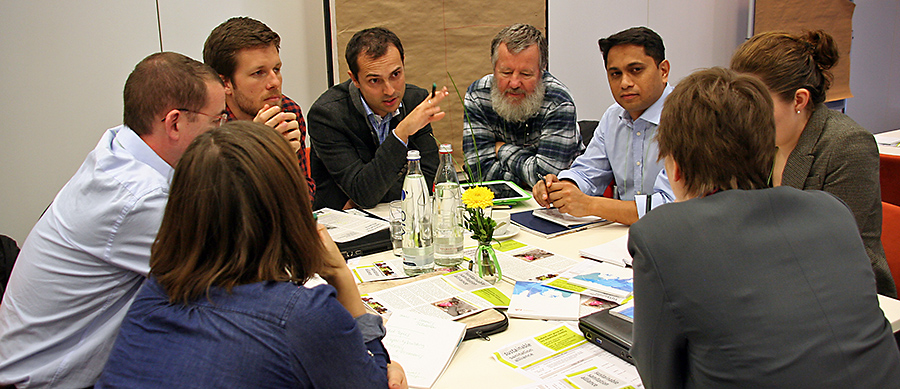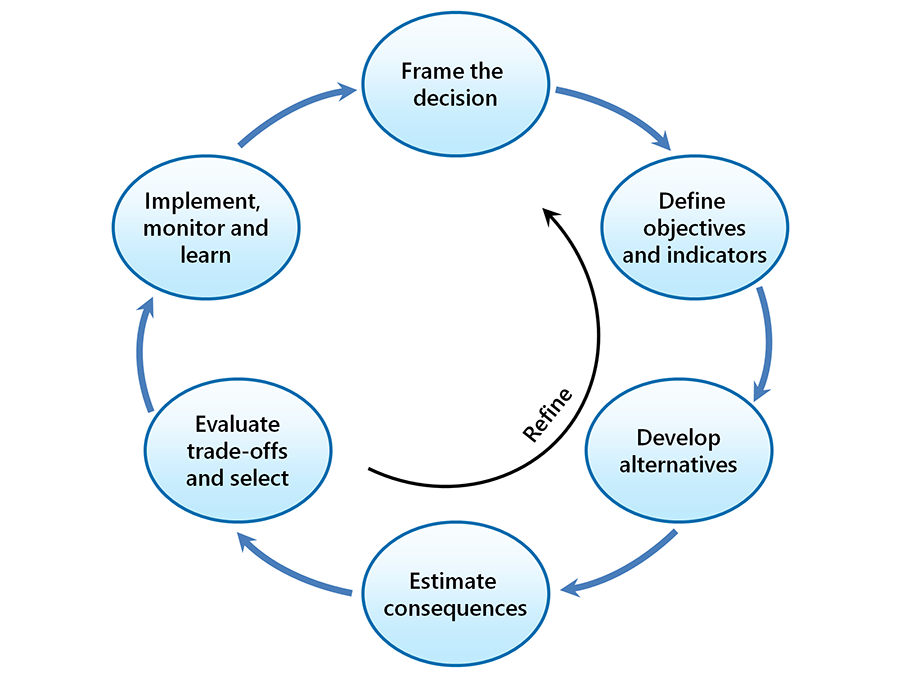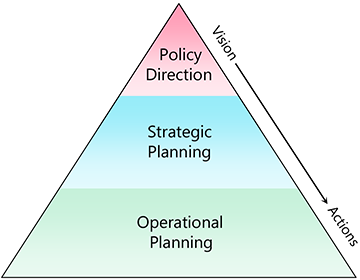Structured Decision Making

In the last few chapters, we have examined the practical methods used for maintaining biodiversity. But there is more to conservation than linking threats with mitigation measures. Conservation is fundamentally a social enterprise. In most applications, trade-offs between conservation objectives and other social objectives must be addressed before any action can be taken. Also, in the face of constraints, it is necessary to determine which conservation objectives are most important and which conservation methods are best suited for a given application. In short, applied conservation entails making decisions.
In this chapter, we will work through the decision-making process, step by step. As our guide, we will use the framework referred to as structured decision making (SDM). This approach is widely accepted as the best practice standard for making management decisions involving multiple objectives (Runge 2011; Gregory et al. 2012; Conroy and Peterson 2013). Many variants of SDM exist, tailored to specific applications (e.g., CMP 2013; Carwardine et al. 2019). We will remain focused on the general principles, which have broad applicability.
General Principles
SDM draws on insights from decision science and cognitive psychology and has been tested and refined through years of application. It is a highly practical approach, described by Gregory et al. (2012) as follows:
SDM is a useful way to deal with the realities of everyday environmental management … SDM reframes management challenges as choices; not science projects, not economic valuation exercises, not consultation processes or relationship builders. You have a decision (or a sequence of decisions) to make. The context is fuzzy. The science is uncertain. Stakeholders are emotional and values are entrenched. Yet you—or someone you are advising—has to make a choice. (p. 2)
In conservation applications, choices come in three main forms, all of which are amenable to SDM:
1. Selection: deciding which action to take when multiple alternatives are available
2. Prioritization: ranking options (e.g., for resource allocation)
3. Identification of breakpoints: determining when to act or how much of a certain action is needed
A key feature of SDM is that it integrates the social and scientific dimensions of conservation decision making. Through SDM, we identify solutions that optimally address multiple objectives while simultaneously building support for implementation. SDM’s effectiveness arises from the structure it provides for thinking through complex problems and navigating difficult trade-offs. The emphasis is on clarifying objectives and understanding the full consequences of management alternatives. The resulting decisions are rigorous, inclusive, defensible, and transparent. The SDM process also reveals key uncertainties and knowledge gaps, providing guidance for research efforts.
Fig. 10.1 presents an overview of the SDM framework. The process begins with decision framing, which establishes the context and scope of the decision. This is followed by a sequence of structuring steps—the heart of SDM—leading to the selection and implementation of a preferred approach.

A useful tool for organizing and visualizing the decision process is a consequence table (Gregory et al. 2012). As illustrated in Table 10.1, a consequence table consists of a set of objectives (rows) and a set of potential management approaches that can be used to achieve those objectives (columns). The cells of the table are filled with predictions of how the management alternatives are expected to perform against each of the objectives. We will work through a simple example as an introduction to the SDM process. This example will serve as a roadmap for the details that follow in the rest of the chapter.
Table 10.1. A simplified SDM consequence table for caribou management.
| Objective | Approach A | Approach B | Approach C |
| Caribou viability | Outcome A1 | Outcome B1 | Outcome C1 |
| Timber harvest | Outcome A2 | Outcome B2 | Outcome C2 |
| Indigenous hunting | Outcome A3 | Outcome B3 | Outcome C3 |
For our example, will use the development of a management plan for woodland caribou. The context is provided by the federal woodland caribou recovery strategy, which sets forth several recovery objectives. Our task is to determine which management action, or combination of actions, should be applied to achieve these objectives in our management area. To be clear, this example is only meant to illustrate how the SDM process works. All of the complexities have been stripped away. In Case Study 3, we will examine a real-world example of caribou recovery planning.
The first step is to define the management objectives, which describe the desired outcomes of a given planning process. Objectives express what matters to us. Under SDM, objectives are defined not only for conservation-related values, but also other social values affected by the decision. In our example, caribou viability is identified as a core objective, as per the recovery strategy (Table 10.1). But objectives related to forestry and Indigenous hunting have also been included because these activities might be affected by recovery measures.
When defining the objectives, we must differentiate the ends (the outcomes we seek) from the means (methods for achieving the ends). We must also specify how the objectives will be measured, allowing the performance of proposed management approaches to be compared. In our example, we might use caribou population size or growth rate as an indicator of caribou viability.
The next step is to develop alternative management actions or strategies that could be used to achieve the objectives. Depending on the situation, these might be distinct management actions, different combinations of actions, or alternative levels of the same action. For example, in Table 10.1, Approach A might represent current management, Approach B might involve innovative industrial practices, and Approach C might involve establishing new protected areas. Hybrid approaches are also possible.
The preferred approach is identified by predicting outcomes for every alternative and then determining which offers the best overall result. The prediction component is meant to be objective and is heavily dependent on science. In contrast, the selection of the best option is generally a matter of social choice because value-based trade-offs are usually involved. In our example, we might use a statistical model to predict caribou population trends under each management alternative. Timber flow and Indigenous hunting opportunities would also be predicted. Decision makers, with input from stakeholders, would then evaluate the overall performance of each approach and make a choice.
Though the SDM process is described here as a linear process, in practice it usually involves iterative refinement. Insights from the prediction and assessment stage may lead to changes in the set of management alternatives and possibly new objectives.
The SDM process is designed to reveal win-win solutions if they exist. However, in most conservation applications, compromises are necessary (McShane et al. 2011). The trade-off between caribou recovery and forest harvesting is a good example. In such cases, decision makers must determine the appropriate balance among objectives—a political decision that typically disappoints some or all stakeholders. SDM is still of value in these situations because it clarifies the values at stake and the likely outcomes of management alternatives. It also brings fundamental trade-offs into high relief. Thus, even if the decision must be made politically, it will be properly informed.
The last stage in the process is implementing the plan and monitoring the outcomes. Monitoring provides insight into the validity of planning assumptions and predictions. It can also be used to support active learning about the system and how it responds to manipulation. The information gained is used to inform future iterations of the planning cycle.
Box 10.1. Decision-Making Terminology
Decision. In SDM, a decision is a judgment or choice involving multiple objectives and alternative courses of action.
Goals and objectives. Goals and objectives describe desired outcomes. Goals are generally broad statements of what is desired. Objectives are subcomponents of a goal and are specific and measurable.
Plan. A plan is an organized collection of decisions supporting a common purpose. It is a roadmap to a desired future, describing where we are going (objectives) and how we will get there (methods).
Strategy. A strategy is similar to a plan; however, strategies have a broader scope and are more abstract than plans. Plans tend to be more operationally focused.
Trade-off. A trade-off arises when a constraint or incompatibility prevents the simultaneous achievement of multiple objectives. One must give up one thing to achieve something else.
Values and preferences. Values are what we fundamentally care about and believe to be important. Values tend to be relatively fixed. Preferences are defined in terms of the trade-offs we are willing to make in a particular situation. They change with the circumstances.
The Decision Hierarchy
The full process of SDM, from problem identification through to implementation, is largely synonymous with the concept of planning. We can think of a plan as a container for one or more SDM decisions supporting a common purpose.

In resource management, planning is hierarchical, and different terms are used to identify the different levels (Fig. 10.2). Policies are at the top of the hierarchy. They establish broad goals and priorities and provide high-level guidance for action. At the bottom are operational plans, which are implementation oriented. In between are layers of strategic plans that translate the broad direction provided by policy into a region or issue-specific context. For example, a polar bear management strategy represents an intermediate step between a policy commitment to maintain biodiversity and the setting of annual polar bear hunting quotas.
Policies, strategies, and operational plans exist along a continuum that lacks clear demarcations. Moving along this continuum, from policy to operations, the scope narrows and the level of detail increases. In addition, decisions become more technical, with less need for social deliberation, since we are increasingly implementing choices made at higher levels.
Although policies are intended to provide context and direction for lower-level initiatives, these linkages are not always clear. As we saw in Chapter 7, the institutional mechanisms for integration are often deficient. Therefore, it frequently requires considerable effort on the part of planners to interpret the broader context they are working within (which is part of decision framing).
Most types of decisions can benefit from SDM; however, high-level government policy decisions are often too broad and complex to structure effectively. High-level policy is usually created through a political process, as described in Chapter 3. SDM also has limited applicability for routine operational decisions that are essentially algorithmic (e.g., the determination of an annual harvest sequence, as directed by a broader forest management plan).
It should be noted that SDM is not limited to government decision making. It can help any organization faced with making decisions that involve difficult trade-offs. For example, a conservation group facing capacity constraints might use SDM to choose among potential projects. Furthermore, the level of detail and effort involved in implementing SDM can be scaled up or down to match the scope and importance of individual applications.
The Role of Conservation Practitioners
Conservation practitioners participate in decision-making processes in three distinct roles: stakeholders, advisors, and decision makers. Practitioners are considered stakeholders when they engage in advocacy, promoting conservation as a planning objective. Such input falls within the social domain of decision making. Practitioners are considered advisors when they contribute technical expertise about how conservation objectives can be achieved. This input falls within the scientific domain of decision making.
The reason for drawing a distinction between advocacy and technical advice is that the social and scientific aspects of decision making need to be handled differently, as we will see in the sections that follow. In principle, there is no reason why a conservation practitioner cannot contribute to both aspects of a decision, so long as the necessary distinctions are maintained. However, decision makers and stakeholders may consider technical advice biased and unreliable if it is coming from an advocate (see Chapter 4).
Conservation practitioners also serve as decision makers, mainly for conservation-oriented planning initiatives in the middle to lower levels of the decision hierarchy. Such initiatives usually take place under the auspices of an agency with a mandate for implementing conservation policy, typically within government, but not exclusively so. Some initiatives may represent the implementation phase of a higher-level strategy, whereas others may be responses to local conservation problems. The case studies in Chapter 11 provide examples of decision making by conservation practitioners in a variety of settings.

